DIY Miniature Cardboard Playground for Playful Language Learning

This DIY miniature cardboard playground was a recent family project that started as a fun building experience and has continued to be fun for playful language learning!
For 2 months, local playgrounds (公园游乐场 / 公園遊樂場 / Gōngyuán yóulè chǎng) were closed. My children have missed climbing and swinging!
Although my kids are great about wearing their cloth masks, we are still social distancing and don’t feel safe about public play structures.
So we’re living vicariously through this recycled toy playground!
Chalk Academy is reader-supported. Some of the links are affiliate links. When you buy something through an affiliate link, we may earn a very small commission at no cost to you. Details here.

If you’re looking for something to make with your kids or want to review bilingual vocabulary about playgrounds, this post is for you!
Benefits of creating a miniature cardboard playground
When I’m extra busy and tired, I sometimes need a boost of motivation to dive into a creative project with my kids!
I know my kids love the magic of making cardboard toys with mommy, and I remind myself that both the process and result have so many benefits!
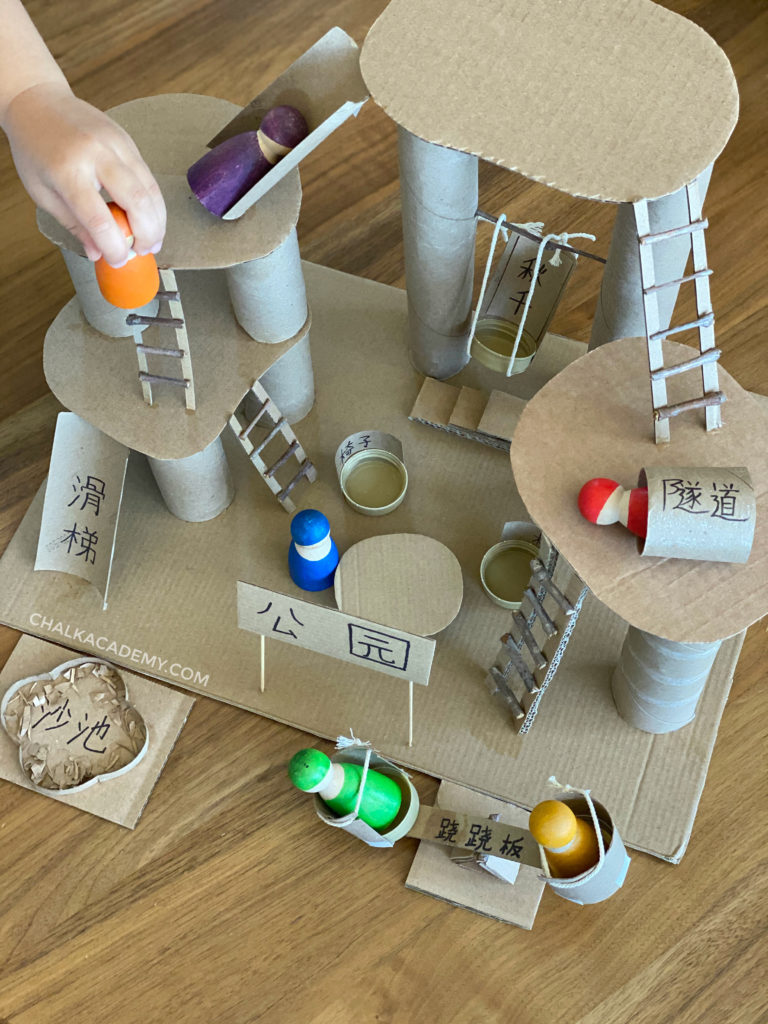
Family bonding
Now that my kids are older, the creation process is much more enjoyable as we can work together! I no longer have to worry about my toddler accidentally destroying it!
My 3-year-old son had fun running back and forth to get recycled materials and art supplies.
Meanwhile, my 6-year-old daughter and I brainstormed the layout and worked in cutting and gluing playground parts together.
My kids have had so much fun playing and coming up with playground scenarios together!

Emotional development
This small word playground is an opportunity for kids to re-enact certain experiences through their little wood peg dolls (木钉娃娃 / 木釘娃娃 / Mù dīng wáwá).
Through play, they can reflect on emotions and real life events in a safe setting.
Especially since my kids have not seen their friends in a while, small world play is an excellent way to practice social skills (eg, imaginary playground play date).
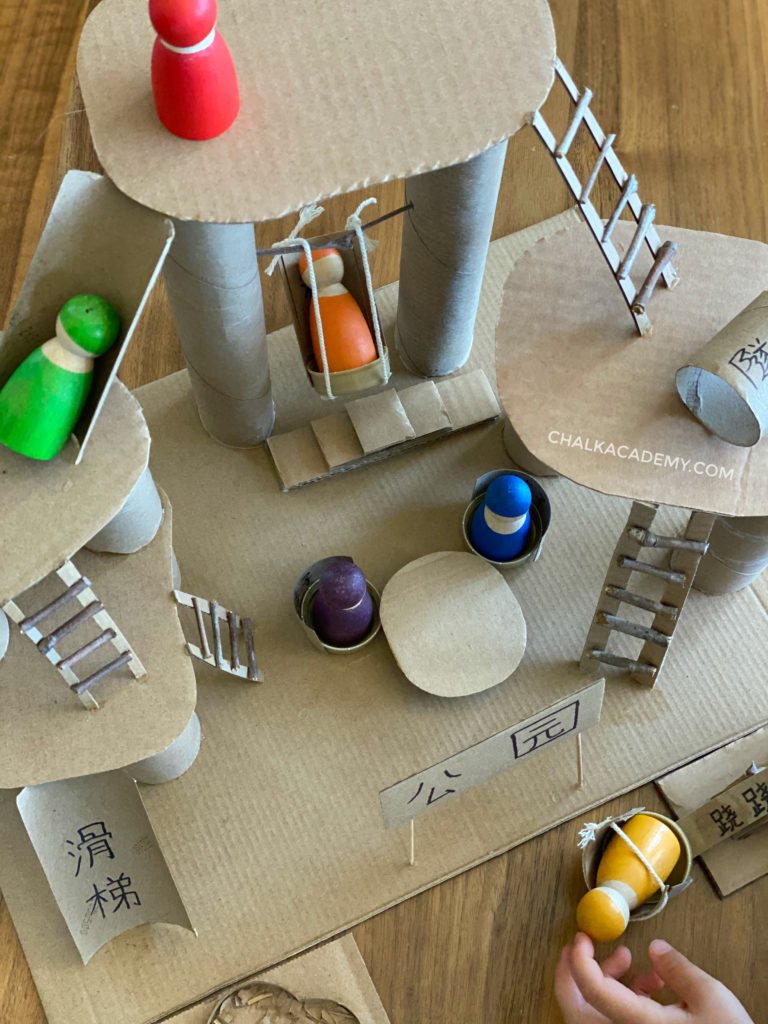
Language skills
This cardboard playground with my kids was a fun way to revisit fond memories while reviewing playground vocabulary in Chinese, the minority language that I speak with my children.
Through crafting and playing, language learning is naturally rich through conversation.
Related: 7 Natural Ways to Improve Communication Skills Through Play

The miniature playground also gives real life grammar practice while we vocalize nouns, verbs, adjectives, and prepositions.
For example: “My brother is in the tunnel under the ladder. 我弟弟在梯子下的隧道里 / 我弟弟在梯子下的隧道裡 (Wǒ dìdì zài tīzi xià de suìdào lǐ).
Related: Learn Chinese Location Words | 我的后面是谁呢? Who’s Behind Me Books
In addition, we label the cardboard playground to create a print-rich environment in our minority language.
By seeing Chinese words on their beloved playground, my younger child can memorize these Chinese characters just like his big sister!

Real world math, reasoning, and problem solving
When creating the miniature playground, we had to count and sort various recycled materials for building.
In addition, we measured and estimated various lengths, and had to make sure we had enough space for each little peg doll to “walk” around!
We had to figure out how to make the structure stable with limited materials!
In addition, my daughter feels strongly that we need to add railings to maximize safety, just like real playgrounds.
We are currently working on building the rails and will update this post with new pictures in the future!
Try this: How to Teach Kids Basic Math for Free
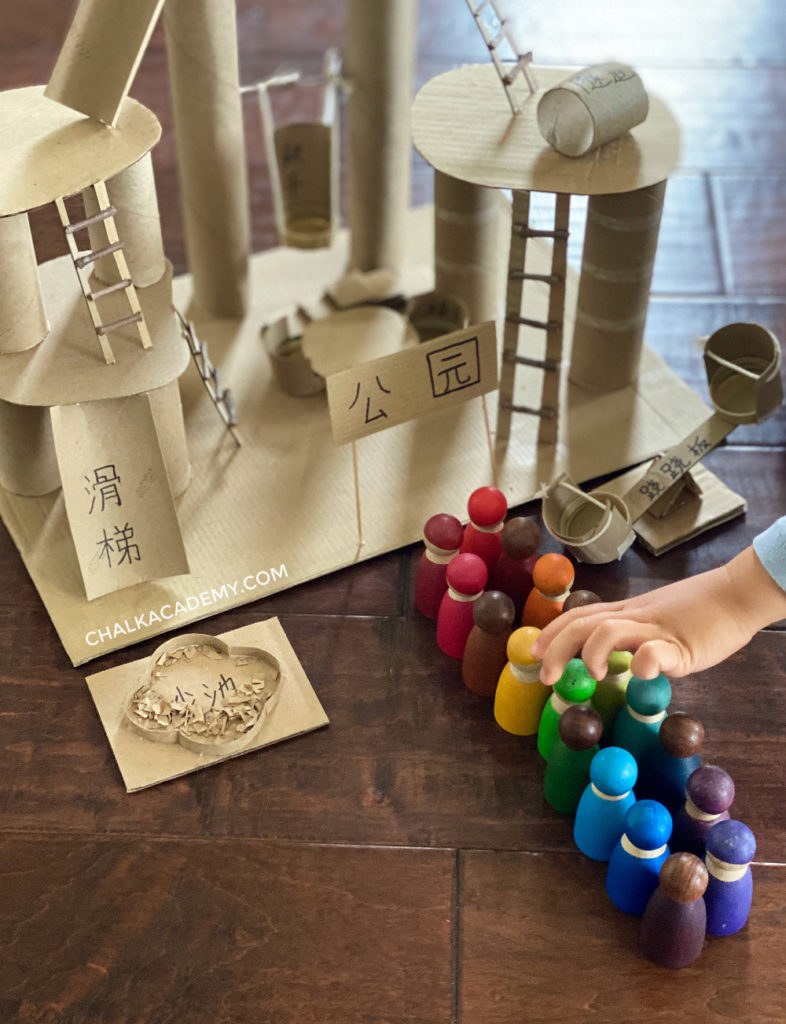
Materials used to make the miniature playground
Here’s what we used to make our cardboard playground!
- Toilet paper rolls 卫生纸筒 / 衛生紙筒 (wèishēngzhǐ tǒng)
- Cardboard 纸板 / 紙板 (zhǐbǎn)
- Scissors 剪刀 Jiǎndāo
- X-acto knife #2 笔刀 (bǐ dāo)
- Glue 胶水 / 膠水 (jiāoshuǐ); we prefer craft tacky glue for our crafty projects
- Twigs 树枝 / 樹枝 (shùzhī) &/or toothpicks 牙签 / 牙籤 (yáqiān)
- Cotton twine 棉线 / 棉線 (miánxiàn)
- +/- Black marker (黑色的马克笔 / 黑色的馬克筆 / Hēisè de mǎkè bǐ)
- +/- Tape 胶带 / 膠帶 (jiāodài) for structural support
Related: 20+ Chinese Learning Activities with Cardboard Rolls!
Details of the miniature playground and how we made the cardboard toys!
Here’s a close-up look at how we put together each part!
We didn’t follow any particular tutorial and just worked with what we had. Our goal was to use only recycled materials!
I encourage you to brainstorm with your child and feel free to refer to this if you’re stuck on any step!
Please don’t feel like yours should look the same or anything close to this!
Every play structure was easy to make except for the see-saw which took a bit of trial and error.
Park sign (公园标志 / 公園標誌 / Gōngyuán biāozhì)

My 6-year-old daughter wrote the park sign in simplified Chinese 公园 (gōngyuán) since most of our resources are in this written script. In traditional Chinese, the characters are 公園, which she is also familiar with.
She chose to use long toothpicks to hold up the sign and learned that we needed to glue the toothpicks for stability.
Sandbox (沙池 / Shā chí) or 沙坑 (shā kēng)

My kids insisted that the playground needed a sandbox, so we used toilet paper roll pieces as the frame and scraps of cardboard as the sand!
Related: 4 Ways to Teach Chinese Characters at the Beach!
Ladders, platforms, and slides (梯子, 平台, 滑梯 / tīzi, píngtái, huátī)

- To make the ladders 梯子 (tīzi), we cut thin strips of cardboard for the side rail and then cut and glued twigs for the rungs.
- To make each platform 平台 (píngtái), we cut large pieces of cardboard and glued them to toilet paper rolls or paper towel rolls.
- For the slides 滑梯 (huátī), we cut cardboard toilet paper rolls in half and glued them to the underside of the platform. To give support while the glue dried, we used a small piece of masking tape.
Cardboard tunnel (纸板隧道 / 紙板隧道 Zhǐbǎn suìdào)

As you can probably tell, the climbing tunnel 爬行隧道 (páxíng suìdào) was the easiest structure to make!
Ironically, the Chinese translation had many strokes and was the hardest to write!
Picnic table and chairs (野餐桌椅 / Yěcān zhuō yǐ)

Each little chair is made of a bottle cap attached to a cut cardboard roll!
The large brown bottle caps from our Ripple pea milk were the perfect size for our wooden peg dolls (Grapat version here)!
The picnic table was really easy for my 6-year-old daughter to make: just a flat piece of cardboard glued to a cut toilet paper roll.
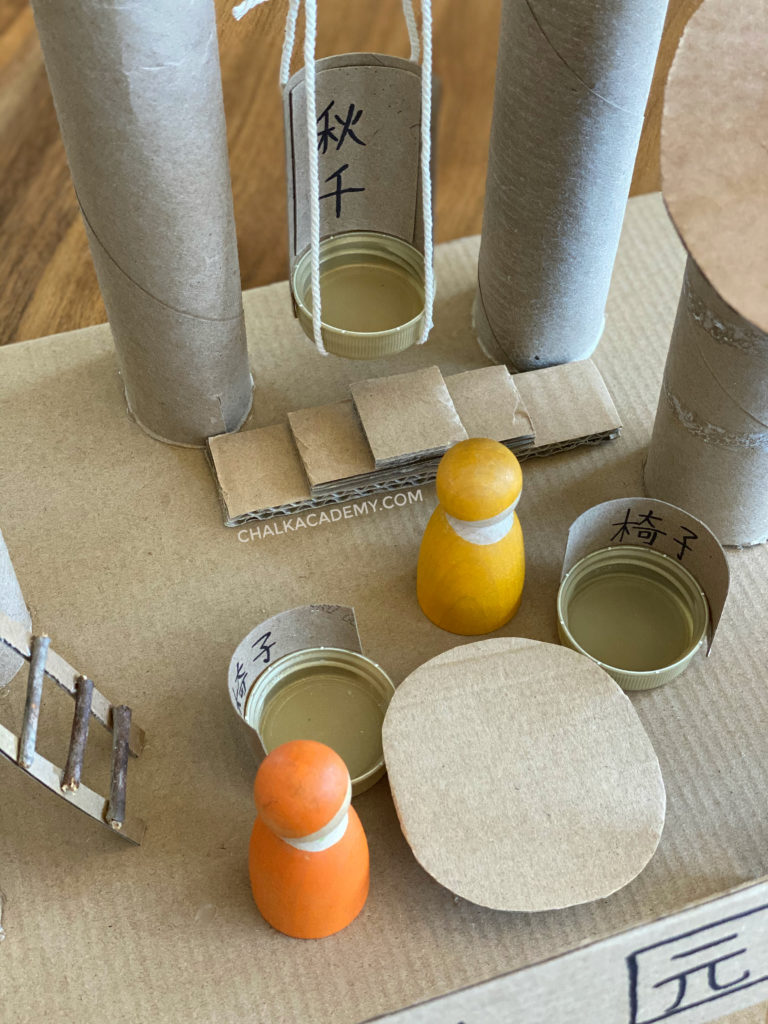
The kids decided to leave the picnic table and chairs free so that they could move it inside and outside of the park!
Cardboard swing (秋千 / 鞦韆 / Qiūqiān)
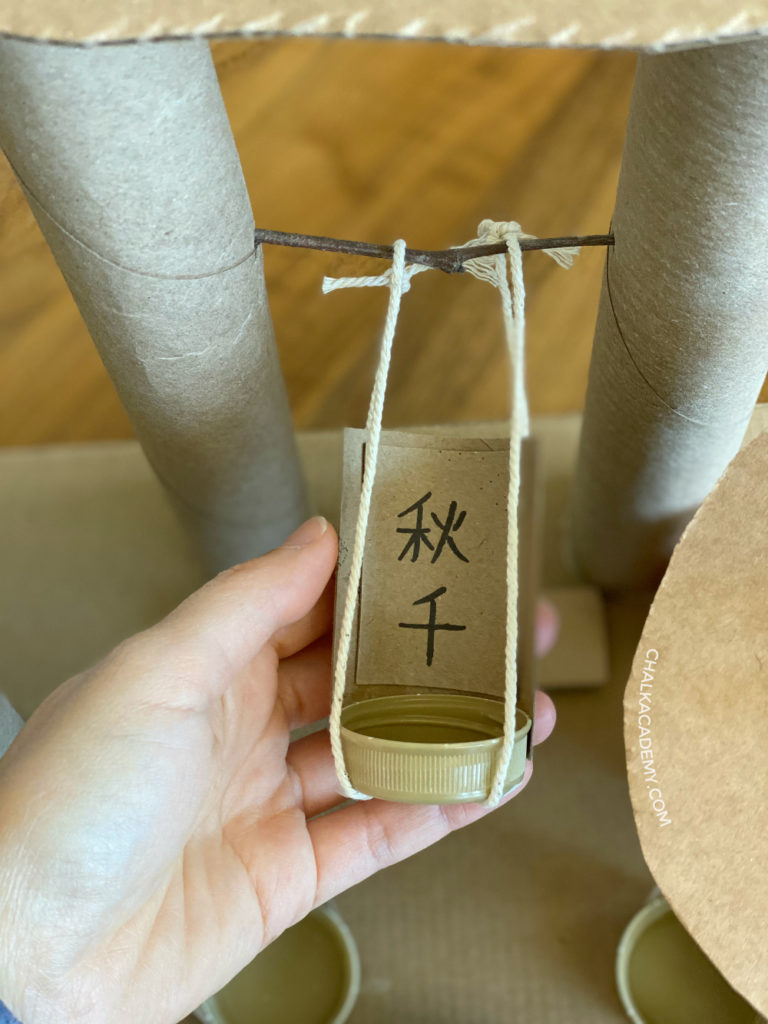
Our mini swing for cardboard small world playground is also made from a cut cardboard roll and bottle cap!
Before gluing the posts down to your base, you should first attach the swing so that you have more freedom of movement for gluing and tying the swing.

Here’s a peek at the back of the cardboard swing with the wood peg dolls (Grapat version here) lined up in rainbow order!
I used my pen knife to cut slits into the cardboard roll posts. Then I inserted a twig into the slot.

Next, I cut 2 pieces of cotton twine (“swing chains”) and attached them to the swing chair with tape and glue as shown in the above photo.
Lastly, I tied the cotton twine swing chains onto the twig!
Related: 3 Easy Ways to Use Bottle Caps for Color Matching (VIDEO)
DIY miniature toy seesaw (微型玩具跷跷板 / 微型玩具蹺蹺板 / wéixíng wánjù qiāoqiāobǎn)

As with the other “chairs”, I used the same bottle caps and cardboard to make the see-saw seats. Later, I realized I needed to add seat belts 安全带 (ānquán dài) so that the wooden dolls (Grapat version here) wouldn’t fall out. I used cotton twine to create the seatbelt.
Each see-saw seat was glued to a long strip of thick cardboard (see-saw beam).

To create the fulcrum, I scored and folded another strip of cardboard into a triangle shape.
Then I put a short twig at the top of the triangle. This is the connecting piece between the beam and the fulcrum and allows the beam to rock back and forth.
To hold it in place, I taped half of the twig to the beam and the other half to the fulcrum.
Later, I realized the see-saw seats were too heavy for the fulcrum. Therefore, I added a rectangular cardboard to the bottom for more stability.

Climbing net 攀爬网绳 / 攀爬網繩 (pān pá wǎng shéng)
This is the playground that my daughter largely made on her own! However, I helped her with this climbing net 攀爬网绳 / 攀爬網繩 (pān pá wǎng shéng):
- Cut desired number of pieces of string
- Lay them in a grid pattern
- Knot the ends
- Use craft glue to secure the overlapping inner pieces
- Glue and/or tape ends to rest of play structure

Climbing rope 徒手爬绳 / 徒手爬繩 (túshǒu pá shéng)
This cute climbing rope was pretty easy to make
- Cut 3-pieces of string
- Knot 1 end
- Braid
- Knot the other end
- Glue/tape to cardboard play structure
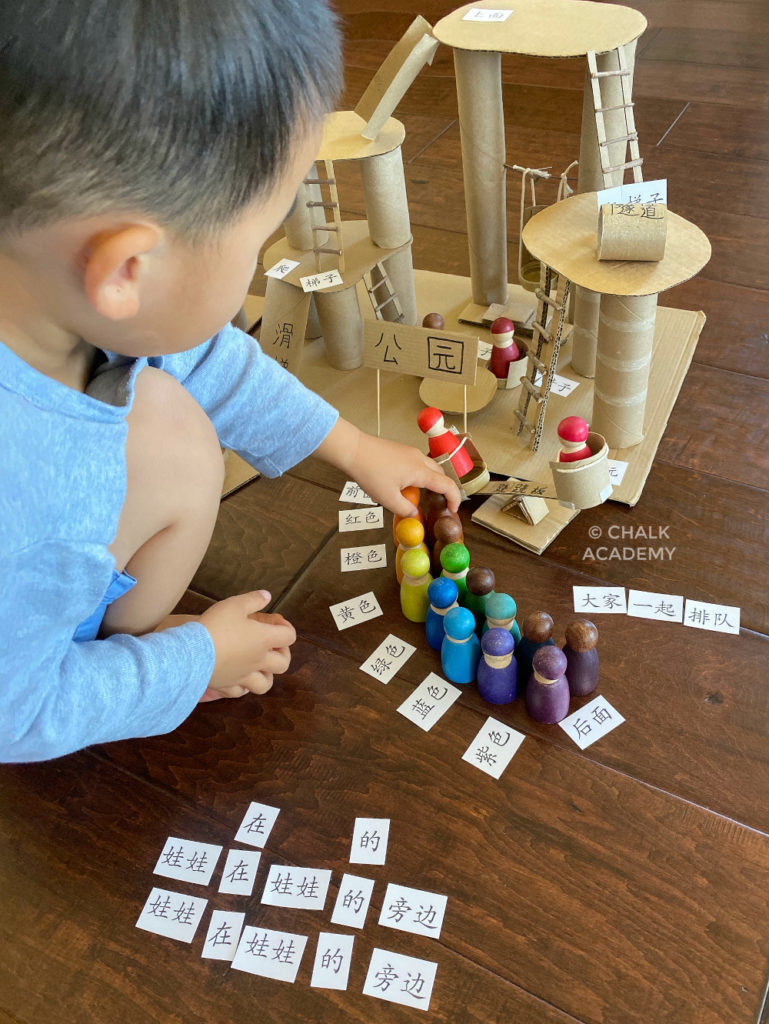
Summary of park and playground vocabulary in Chinese
For busy parents who are learning Mandarin Chinese with their children like us, here is a summary of common playground translations!
Simplified Chinese, traditional, and Hanyu Pinyin are included below.
Please note that there may be regional variations, which is normal with any language.
- Park 公园 (gōngyuán)
- Playground 游乐场 / 遊樂場 (yóulè chǎng)
- Balance beam 平衡木 (pínghéngmù)
- Basketball court 篮球场 / 籃球場 (lánqiú chǎng)
- Bench 公园长椅 / 公園長椅 (gōngyuán cháng yǐ)
- Bridge 桥 / 橋 (qiáo)
- Chair 椅子 (yǐzi)
- Climbing net 攀爬网绳 / 攀爬網繩 (pān pá wǎng shéng)
- Climbing rope 徒手爬绳 / 徒手爬繩 (túshǒu pá shéng)
- Climbing tunnel 爬行隧道 (páxíng suìdào)
- Climbing wall 攀岩墙 / 攀岩牆 (pānyán qiáng)
- Drinking fountain 饮水机 / 飲水機 (yǐnshuǐ jī)
- Gazebo 涼亭 (liángtíng)
- Hanging bar 单杠 / 單槓 (dān gàng)
- Hopscotch 跳房子 (tiàofángzi)
- Jungle gym 攀爬架 (pān pá jià)
- Ladder 梯子 (tīzi)
- Monkey bars 猴架 (hóu jià)
- Platform 平台 (píngtái)
- Picnic table 野餐桌 (yě cānzhuō)
- Railing 栏杆 / 欄杆 (lángān)
- Restroom 卫生间 / 衛生間 (wèishēngjiān)
- Sandbox 沙池 (shā chí) or 沙坑 (shā kēng)
- Sandcastle 沙堡 (shā bǎo)
- Seesaw 蹺蹺板 (qiāoqiāobǎn)
- Slide 滑梯 (huátī)
- Sliding pole 滑柱 (huá zhù)
- Swing 秋千 / 鞦韆 (qiūqiān)
- Spring rider 弹簧椅 / 彈簧椅 (tánhuáng yǐ)
- Statue 雕像 (diāoxiàng)
Will you make a cardboard playground with your kids?
If you try this activity, please let us know in the comments below! What age(s) are your kid(s), and how did it go? We’d love to hear about your learning experience!
I hope your family has a lot of fun learning and playing with the cardboard playground!



